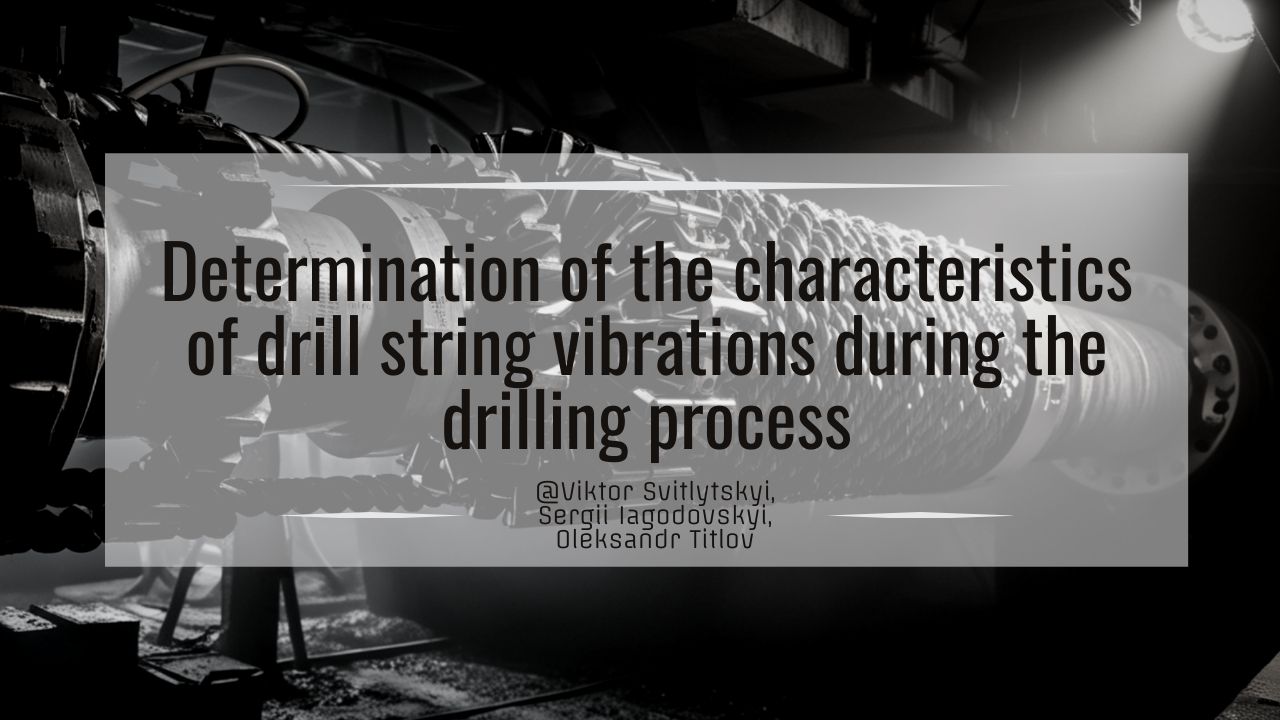Determination of the characteristics of drill string vibrations during the drilling process
DOI:
https://doi.org/10.15587/2706-5448.2024.307806Keywords:
well drilling, drill string, vibration reliability, hydrodynamic cavitation, cavitation generator designAbstract
The object of research is vibration processes of a certain origin in the drill string with typical design deviations depending on the mode parameters of drilling. A drill string is an oscillating system with an infinite number of degrees of freedom of a multifactor system. An exhaustive study of oscillatory processes in the drill string is impossible neither analytically nor experimentally, due to the specifics of the hole deepening in various rocks, the design of the well, its shape, etc. Therefore, in practice, they try to solve the problems of the dynamics of the drill string for an idealized system and, while preserving the main oscillatory properties, solve some problems of the rod system. The work carried out was aimed at experimental studies of vibrations of the drill string during the drilling process.
It is shown that the effectiveness of the use of hydrodynamic cavitation requires the development of methods and devices for intensifying the well drilling process. It is proven that the design of the cavitation generator organically fits into the existing well drilling equipment and allows for the intensification of technological processes with lower specific energy consumption. It is found that all oscillatory processes that occur in the drill string are random in nature and must be considered using the mathematical apparatus of the theory of random oscillations.
The study of vibrations during well drilling shows that vibrations can be considered as random stationary processes, since transient modes have a sufficiently short duration for homogeneous rocks with fixed drilling modes. The analysis of the vibrations of the drill string elements based on random oscillations in a number of cases allows to increase the reliability of determining the vibration reliability of the drill string elements. It has been proven that the response of drill string elements to broadband random vibration can be defined as the combined effect of several narrowband random vibrations.
References
- Besaisow, A. A., Payne, M. L. (1988). A Study of Excitation Mechanisms and Resonances Inducing Bottomhole-Assembly Vibrations. SPE Drilling Engineering, 3 (1), 93–101. doi: https://doi.org/10.2118/15560-pa
- Ghasemloonia, A., Geoff Rideout, D., Butt, S. D. (2015). A review of drillstring vibration modeling and suppression methods. Journal of Petroleum Science and Engineering, 131, 150–164. doi: https://doi.org/10.1016/j.petrol.2015.04.030
- Gurov, A. F. (1966). Raschet na prochnost i kolebaniia v raketnykh dvigateliakh. Mashinostroenie, 453.
- Doghmane, M. Z., Bacetti, A., Kidouche, M. (2020). Stick-Slip vibrations control strategy design for smart rotary drilling systems. Proceedings of the International Conference in Artificial Intelligence in Renewable Energetic Systems ICAIRES. Tipaza, 197–209. doi: https://doi.org/10.1007/978-3-030-63846-7_20
- Liu, S., Ni, H., Jin, Y., Zhang, H., Wang, Y., Huang, B., Hou, W. (2022). Experimental study on drilling efficiency with compound axial and torsional impact load. Journal of Petroleum Science and Engineering, 219, 111060. doi: https://doi.org/10.1016/j.petrol.2022.111060
- Ogorodnikov, P. I. (1991). Upravlenie uglubleniem skvazhyn na baze izucheniia dinamicheskikh protcesov v burilnoi kollone. Doctoral dissertation; MINKh i GP im. ak. Gubkina I. M.
- Ullah, F. K., Duarte, F., Bohn, C. (2016). A Novel Backstepping Approach for the Attenuation of Torsional Oscillations in Drill Strings. Solid State Phenomena, 248, 85–92. doi: https://doi.org/10.4028/www.scientific.net/ssp.248.85
- Saroian, A. E. (1979). Burilnye kolonny v glubokom burenii. Nedra, 229.
- Modelling of Hydraulic Systems. Hydraulics Library Manual and Tutorial (2013). Modelon AB; Maplesoft.
- Mendil, C., Kidouche, M., Doghmane, M. Z. (2020). Modeling of Hydrocarbons rotary drilling systems under torsional vibrations: A survey. Proceedings of the International Conference in Artificial Intelligence in Renewable Energetic Systems ICAIRES. Tipaza, 243–251. doi: https://doi.org/10.1007/978-3-030-63846-7_24
- Iunin, E. K., Khegai, V. K. (2004). Dinamika glubokogo bureniia. Nedra, 285.
- Pilipenko, V. V. (1989). Kavitatcionnye avtokolebaniia. Kyiv: Naukova dumka, 316.
- Svitlytskyi, V. M., Ohorodnikov, P. I., Polovyi, A. Ya. (2018). Pat. No. 123119 UA. Rehuliator dynamichnoho navantazhennia na vybii. MPK E21V17/06. No. u201708767; declareted: 31.08.2017; published: 12.02.2018, Bul. No. 3.
- Svitlytskyi, V. M., Ohorodnikov, P. I., Polovyi, A. Ya. (2018). Pat. No. 123120 UA. Prystrii rehuliuvannia dynamichnoho navantazhennia na vybii. MPK E21V17/06. No. u201708768; declareted: 31.08.2017; published: 12.02.2018, Bul. No. 3.
- Iavorskyi, M. M., Ohorodnikov, P. I., Svitlytskyi, V. M., Maliarchuk, B. M., Khudolei, V. Yu. (2008). Pat. No. 29225 UA. Shpyndel turbobura. MPK E21V4/00. No. u200708866; declareted: 01.08.2007; published: 10.01.2008, Bul. No. 1.
- Ohorodnikov, P. I., Svitlytskyi, V. M., Shcherbatiuk, Yu. Z., Fesenko, Yu. L., Kryvulia, S. V., Kotsaba, V. I. et al. (2012). Pat. No. 72884 UA. Hidrodynamichnyi henerator kolyvan. MPK E21V43/25. No. u201203814; declareted: 29.03.2012; published: 27.08.2012, Bul. No. 16.
- Rice, S. O. (1944). Mathematical Analysis of Random Noise. Bell System Technical Journal, 23 (3), 282–332. doi: https://doi.org/10.1002/j.1538-7305.1944.tb00874.x
- Bendant, Dzh., Pirsol, A. (1974). Izmerenie i analiz sluchainykh protcessov. Mir, 463.
- Pervoznanskii, A. A. (Ed.) (1967). Sluchainie kolebaniia. Mir, 356.
- Nikolaenko, N. A. (1967). Veroiatnostnye metody dinamicheskogo rascheta mashinostroitelnykh konstruktcii. Mashinostroenie, 367.

Downloads
Published
How to Cite
Issue
Section
License
Copyright (c) 2024 Oleksandr Titlov, Viktor Svitlytskyi, Sergii Iagodovskyi

This work is licensed under a Creative Commons Attribution 4.0 International License.
The consolidation and conditions for the transfer of copyright (identification of authorship) is carried out in the License Agreement. In particular, the authors reserve the right to the authorship of their manuscript and transfer the first publication of this work to the journal under the terms of the Creative Commons CC BY license. At the same time, they have the right to conclude on their own additional agreements concerning the non-exclusive distribution of the work in the form in which it was published by this journal, but provided that the link to the first publication of the article in this journal is preserved.







